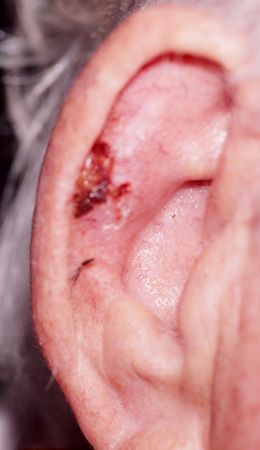- Clinical Technology
- Adult Immunization
- Hepatology
- Pediatric Immunization
- Screening
- Psychiatry
- Allergy
- Women's Health
- Cardiology
- Pediatrics
- Dermatology
- Endocrinology
- Pain Management
- Gastroenterology
- Infectious Disease
- Obesity Medicine
- Rheumatology
- Nephrology
- Neurology
- Pulmonology
Ulcerated Lesion on Ear: Benign or Malignant?
This rounded 0.5-cm ulcerated lesion with a slightly raised border between the helix and the antihelix had been present on an 85-year-old man’s ear for an unknown period.

This rounded, 0.5-cm ulcerated lesion with a slightly raised border between the helix and the antihelix had been present on an 85-year-old man’s ear for an unknown period. It was asymptomatic except for some bleeding. An incisional elliptical biopsy was done in the office.
What diagnosis would you suspect?
(Answer on next page)
The pathologic diagnosis was ulcerated infiltrating basal cell carcinoma. The patient chose radiation treatment, which yielded good cosmetic results.
Basal cell carcinoma is the most common invasive malignant cutaneous neoplasm. The usual symptoms are bleeding and scabbing. It rarely metastasizes. If left untreated, the lesion may erode by direct extension. Many basal cell carcinomas occur in sun-exposed areas; 85% occur on the head and neck. It occurs only rarely in blacks. Caucasians have a 30% risk of basal cell carcinoma, especially the elderly. Men are affected twice as often as women.
Basal cell carcinomas are divided into 5 histologic types: nodular (21%), superficial (17%); micronodular (15%); infiltrative (7%); and morpheaform (1%). Mixed patterns are present in 38.5%. Clinical types of basal cell carcinoma are nodular, pigmented, cystic, sclerosing or morpheaform, and superficial.
Treatment depends on the clinical type, histology, tumor size, and location. Options include excisional biopsy, electrodessication and curettage, Mohs micrographic surgery, radiation, imiquimod 5% cream, and 5-fluorouracil cream.
This case serves as a good reminder that the primary care clinician is capable of diagnosis and either treating or referring the patient for appropriate treatment.
